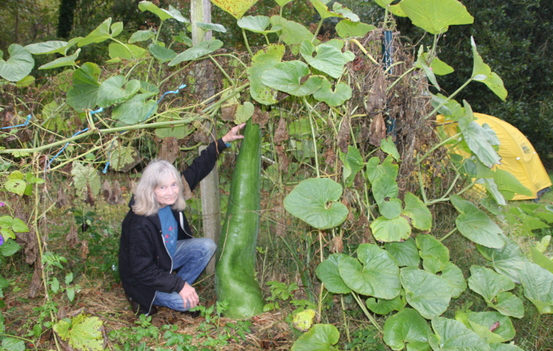
Cindy Quinn with her giant, 5 foot tall, squash on October 16 — Photo by Jane Jewell
When Cindy Quinn of Still Pond planted one corner of her vegetable garden with squash last June, she had no notion what a big surprise she was in for. A real big surprise!
Quinn grew up visiting her grandparents in Kent County every summer. She loved the swimming and boating and developed a great appetite for hiking, camping, and the outdoor life. Then in 1986, she bought her own home in Still Pond, moving there to raise her two young sons in the rural Eastern Shore landscape she had come to love. That year she started a garden and has had one every year since. There are now eleven separate garden areas spread over one-third acre – in front, to the side, and behind her house — all of which she has dug and planted by hand. Over the years, Quinn has planted flowers, herbs, native grasses, and lots of vegetables—which she eats or gives away to friends and family. If you know Cindy, you’ve probably received a brown bag full of her most recent crop. She says that she has planted a wide variety of foods and flowers, always trying something new, figuring out what grows best. But also always growing certain staples and favorites such as onions, chard, arugula, garlic — sometimes zucchini, watermelon, carrots, plus anything that looks good when she’s at the garden store or leafing through the seed catalog.

Cindy Quinn with two smaller squashes on the same runner as the giant squash – photo by Jane Jewell
Working with his mother in the garden while he was growing up has made a big difference in the life of Cindy’s younger son, Greg Grim. Greg is now an organic farmer in West Virginia where he grows vegetables using the “high tunnel” method. He sells his produce in a local farmers market much like the one that he grew up visiting on Saturday mornings in Chestertown. He also works at a local bee farm where he takes care of the hives and helps with a program that provides beehives and training to people who would like to have bees in their backyards. Greg joined the program because he wanted to be part of the fight to save and promote bees, hopefully reversing the world-wide decline of these essential pollinators.
Greg is the one who brought his mother a few squash seeds that he had left-over from a packet of Boston Marrow squash that he had planted in his own garden. But what grew in Cindy’s garden was not the same as the ordinary Boston Marrow squash that grew from the rest of the seeds in the pack in her son’s 1,000-foot long high-tunnel greenhouses in West Virginia.
The Boston Marrow squash is normally a bright orange while the giant squash and its siblings are definitely green. The Boston Marrow is shaped more like the Butternut squash with a short curved neck and a very rounded body. The squashes growing in Cindy’s garden are all long and narrow, rounding out a little at the end more like a zucchini in shape. An heirloom variety, the Boston Marrow squash has a long documented history, going back over 200 years. Legend says that it was one of the vegetables that the Indians provided for the early settlers in New England and may even have been served at the first Thanksgiving. The Boston Marrow can grow large. While the typical fruit will be 10-20 pounds, it can weigh in anywhere from 5-50 pounds according to Garden Diaries. See the Garden Diaries website for a discussion of the Boston Marrow and a good recipe for an alternative to pumpkin pie made from this traditional squash. But you won’t see it in Cindy’s garden despite what the seed package said.
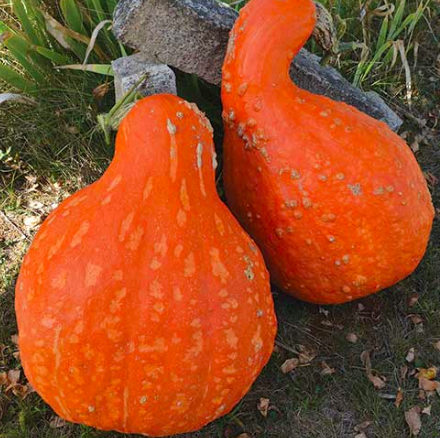
Boston Marrow Squash – an heirloom variety that was very popular and grown widely in the US in the 1800s. Not the giant squash.
Cindy’s son suspects that either a different species of seed accidentally got in with the Boston Marrow seeds at the packagers – or that a few seeds had, unbeknownst to the harvesters, cross-pollinated with another squash variety. Or maybe it was precisely the right combination of sun, soil, shade, and nutrients. Or maybe Mother Nature was just having fun.
Whatever it was, by mid-August, Cindy was aware that the mere 2 or 3 squash seeds that she’d planted were growing prodigiously, putting out three or four long runners, each 20-40 feet long with large green leaves and more than a dozen large green squashes. The runners grew along the ground, up and along the wire fence surrounding the garden, and then out the garden gate onto the lawn beside the house. The leaves were like large lily pads, 6 to 7 inches or more in width with a spikey flower at the end of the runner. The squashes were larger than anything she’d ever seen. And one squash that was hanging in a shady corner at the top of the fence was an absolute giant —two-three times larger than its fellow squashes on the same runner. And most of those were already well over a foot long.
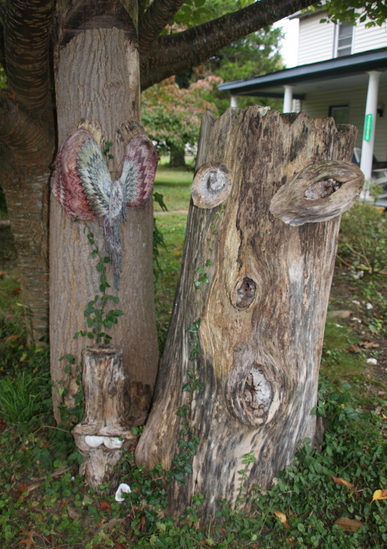
The “Stump Family” a mother, father and baby (with oyster-shell eyes) created by Cindy Quinn’s son Greg Grim from trees relocated from her grandparents Kent County home. – Photo by Jane Jewell
Quinn is now retired from a career as a special education teacher and, after she moved to the Eastern Shore, as an activities director at the Kent County Adult Day Care Center which she helped found and at two local nursing and rehabilitation facilities including Magnolia Hall Nursing Home (now the University of Maryland Shore Nursing and Rehabilitation Center at Chestertown). Both her sons graduated from Kent County High School and then went on to graduate from St. Mary’s College in Maryland.
When not gardening, Cindy enjoys painting watercolors and making various crafts. Not surprisingly, many of her craft projects use natural materials that she collects from her garden and on walks through the local countryside. She makes wreaths for the fall and Christmas seasons. She also dries flowers for floral arrangements.
Her son Greg has inherited her artistic interests and talent. He likes to work with wood and has made a “family” of statues from wood that he collected on his great-grandfather’s home on the Sassafras River where his mother got her early introduction to the Eastern Shore. When that family home was sold about ten years ago, Greg gathered several logs and tree stumps, added knots and other bits of wood to create a mother-father-and baby trio of tree stump sculptures. He transferred the “Stump Family” to the front yard of his mother’s house in Still Pond where, though now very weathered, the trio still resides today. Over the years the stump family members have been decorated and clothed with various colorful items such as hats, scarves, and a knitted bikini top for the mother stump. Greg also fashioned a bed for his first apartment out of salvaged wood from the old family home.
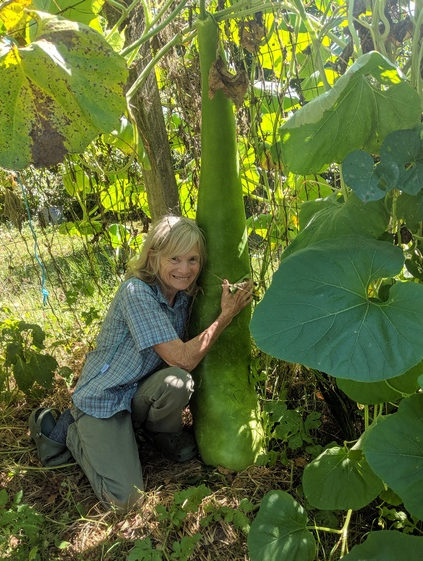
Cindy and the Squash – love at first sight (or bite) — Photo by Jane Jewell
When the Spy first visited the giant squash in mid-Sept, it was almost 4 feet in length. Quinn had propped it up and tied it to the wire fence to help it continue to grow. Then a couple of weeks later in early October, she called to say that she thought the giant squash might be coming to its natural end. One of the main runners had turned brown and died. But a week later she reported that despite the death of the runner, the giant squash was hanging in there, still healthy and growing. When the Spy came for its second visit this Wednesday, the squash was still green and had grown almost a foot in length plus several inches in width since our first photo in September. It has begun to slump a little on the ground. Quinn thinks it’s possible that if the fence had been higher and she had been able to stake it higher, the squash might have grown even taller rather than slumping and gaining width. We’ll never know.
Quinn said she has already eaten several of the “small” squashes. She roasted them to get a crunchy texture and reports that they were delicious, tasting similar to zucchini. She plans, of course, to save the seeds from the giant squash and some from one of its smaller siblings as a control group.
Quinn has promised to keep the Spy updated and let us know when she finally harvests it, if she eats it, and what it’s final length turns out to be. But now, as of Wednesday, October 16th, the giant squash is five feet tall. And so is Quinn. Stay tuned for further reports on the giant squash in Still Pond.
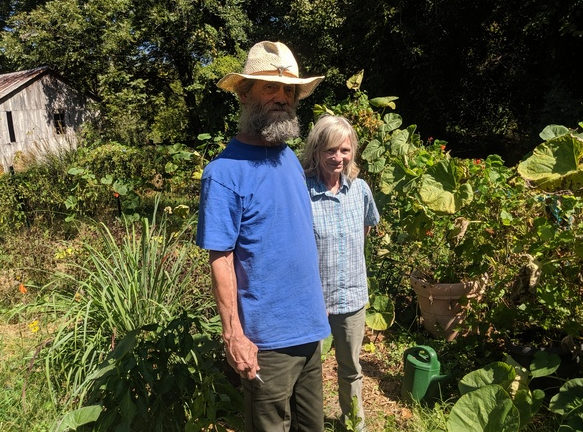
Cindy Quinn with friend Dorsey Westcott who has helped with the garden and alerted the Spy to the presence of the giant squash. – photo by Jane Jewell
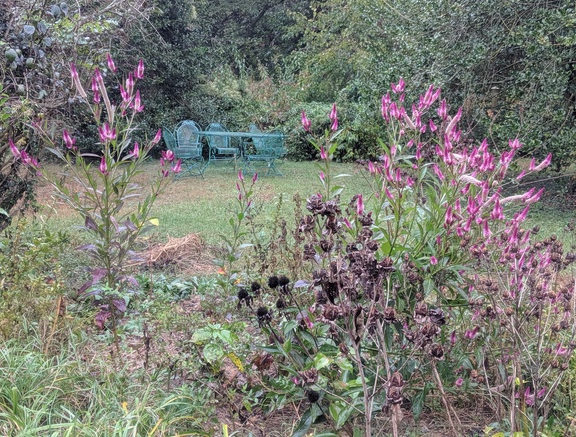
Celosia flowers planted near the front of Quinn’s property in Still Pond — Photo by Jane Jewell
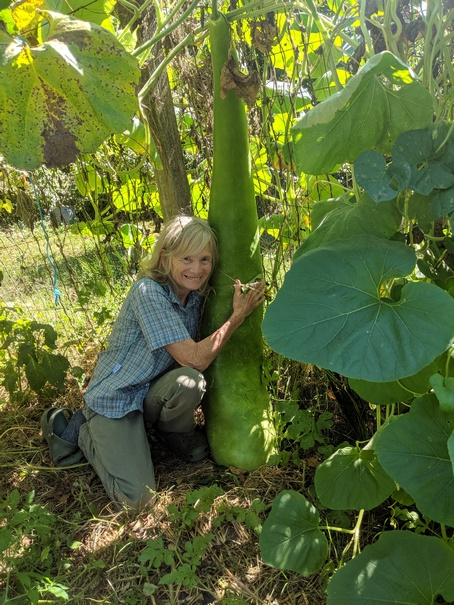
Cindy and the Squash – love at first sight (or bite) — Photo by Jane Jewell
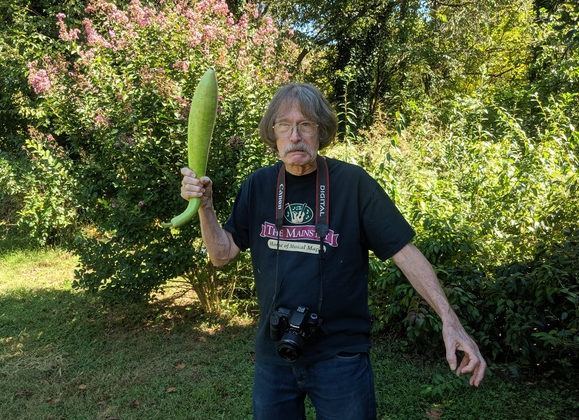
Intrepid Spy reporter and photographer Peter Heck with the giant squash’s baby brother, prepared to fend off giant vegetables if necessary. It wasn’t. (Heck on right in black Mainstay T-shirt, squash in green on left) – photo by Jane Jewell
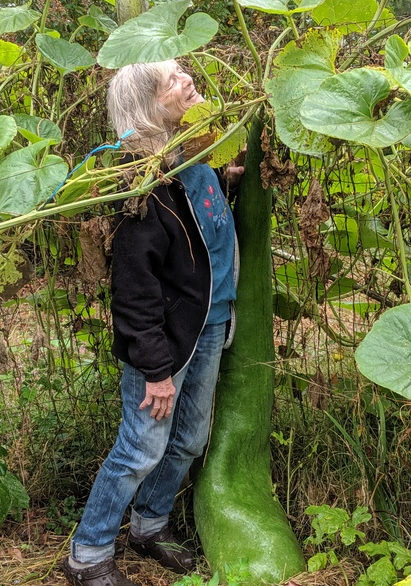
Stretching to tip-toe, Cindy Quinn, at 5′ even, is just barely taller than the giant squash. However, if the squash wasn’t slumping, it might well beat her by a fraction of an inch or so. — Photo by Jane Jewell
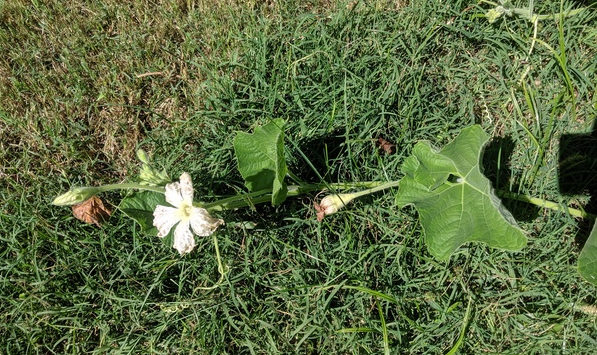
Flowered end of giant squash runner — Photo by Jane Jewell
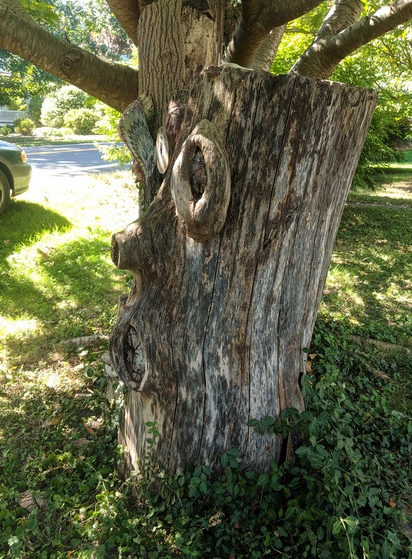
Profile view of “Papa Stump” by Greg Grim. Note the knot-hole features – eyes, nose. and mouth. — Photo by Jane Jewell
###



David Quinn says
Cool stuff!!
Ginny Davis says
Well this made my day! As a former Chestertown resident, I visited Still Pond a few times and loved it’s relaxed, friendly vibe. This is a wonderful story, just the sort of thing people need to be reading in these troubling times. Loved all the pics!
Mimi Hook says
It must have been fun (and a little scary) to watch it grow. I wonder if it will be edible. Let us know its final weight height and disposition.